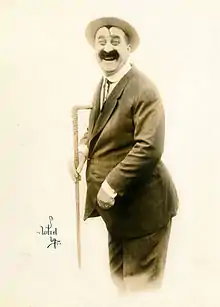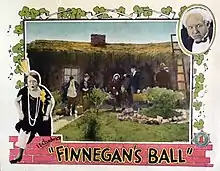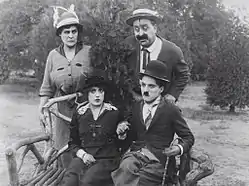Mack Swain | |
|---|---|
 Photograph by Albert Witzel, 1920 | |
| Born | Moroni Swain February 16, 1876 Salt Lake City, Utah, U.S. |
| Died | August 25, 1935 (aged 59) Tacoma, Washington, U.S. |
| Occupation(s) | Actor, vaudevillian |
| Years active | 1913-1935 |
| Spouse |
Cora Claire King (m. 1899) |
Mack Swain (born Moroni Swain;[1] February 16, 1876 – August 25, 1935) was a prolific early American film actor, who appeared in many of Mack Sennett’s comedies at Keystone Studios, including the Keystone Cops series. He also appeared in major features by Charlie Chaplin and starred in both the world's first feature length comedy and first film to feature a Movie-within-a-movie premise.
Early years
Swain was born on February 16, 1876, to Robert Henry Swain and Mary Ingeborg Jensen in Salt Lake City, Utah, and was educated in Salt Lake City's public schools. At age 6 he put on his first act called "Mack Swain's Mammoth Minstrels" in the family barn. At age 8 he stole all of his mother's sheets and linens to build his own circus tent. He ran away from home at age 15, joining a minstrel show. His mother took him home after one performance, but he persuaded her to let him continue in entertainment.[2]
Career
In the early 1900s, Swain had his own stock theater company, the Mack Swain Co., which performed in the western[3] and midwestern United States.[4] His most notable residency, was in Santa Cruz, California, where at one point he was bringing in 6,000 patrons a week to see his performances; over two-thirds the population of the city at the time.[5] On June 24, 1907, the Mack Swain Co. had its 61st show in 50 days, breaking the record by any theater company ever appearing in Santa Cruz. That same year Swain bought the Alisky Theatre, and changed its name to Swain’s Theatre.[5] By 1913, audience attendance had begun to dry up and with it Swain's theatrical career. Mack was initially hesitant to work in the film industry, viewing it as an "inferior art form to theater," but eventually gave in after many of his fellow actors and peers had done the same.
His first foray into silent film began at Keystone Studios under Mack Sennett. His first dressing room was shared with Roscoe "Fatty" Arbuckle. Shortly after arriving at Keystone, Charlie Chaplin too joined the studio and the two quickly teamed up. Swain would later recall that Sennett initially saw him and Chaplin as a burden, and encouraged the two to work together. These early films such as: Laughing Gas (1914) and Mabel's Married Life (1914) would forge a friendship between the two that would endure until Swain's death. Chaplin would later state that his idea for his infamous character, The Tramp, came from him rummaging through Swain's and Arbuckle's dressing room; the baggy clothes from Arbuckle and the iconic mustache from one of Swain's own fake mustaches.[5] Swain and Chaplin would eventually star in the world's first feature length comedy, Tillie's Punctured Romance (1914). Chaplin soon left Keystone and Swain paired up with Chester Conklin to make a series of comedy films. With Swain as "Ambrose" and Conklin as the grand mustachioed "Walrus", they performed these roles in several films including The Battle of Ambrose and Walrus and Love, Speed and Thrills, both made in 1915. Another of Swain's early comedies made a cinematic first; his A Movie Star (1916) was the first film to feature a movie within a movie premise.
_-_Ad_1.jpg.webp)
Besides these comedies, the two appeared together in a variety of other films, 26 all told, and they also appeared separately and/or together in films starring Mabel Normand, Charles Chaplin, Roscoe Arbuckle and most of the rest of the roster of Keystone players.
Swain later took his Ambrose character with him to the L-KO Kompany. Having already worked with Charles Chaplin at Keystone, Swain began working with Chaplin again at First National in 1921, appearing in The Idle Class, Pay Day, and The Pilgrim. He is also remembered for his large supporting role as Big Jim McKay' in the 1925 film The Gold Rush,[1] for United Artists, written by and starring Chaplin.[6]
Personal life
Swain was married to actress Cora King.[7]
Death
Swain died on a train bound from Chicago to Hollywood in August 25, 1935, following an illness that only lasted a few hours. He was buried in Tacoma, Washington[6]
It is rumored that an accident sustained in an early Keystone Cops skit involving Roscoe “Fatty” Arbuckle kicking him in the stomach, eventually led to his death.
Legacy
_(IA_motionpicturenew161unse)_(page_1250_crop).jpg.webp)
For his contribution to the motion picture industry, Swain received a star on the Hollywood Walk of Fame, at 1500 Vine Street.[8]
Partial filmography

| Year | Title | Role | Notes |
|---|---|---|---|
| 1914 | A False Beauty | The Policeman | |
| 1914 | Caught in the Rain | Husband | Short |
| 1914 | His Musical Career | Mike aka Ambrose - Tom's Partner | Short |
| 1914 | Tillie's Punctured Romance | John Banks | |
| 1914 | Getting Acquainted | Ambrose | Short |
| 1915 | Love, Speed and Thrills | Short | |
| 1916 | A Movie Star | Handsome Jack | Short |
| 1917 | Lost- A Cook | Cook | |
| 1921 | The Idle Class | Edna's Father | Short, Uncredited |
| 1922 | Pay Day | Foreman | Short |
| 1923 | The Pilgrim | Deacon Jones | |
| 1925 | The Gold Rush | Big Jim McKay | |
| 1925 | The Eagle | Innkeeper | Uncredited |
| 1926 | Hands Up! | Silas Woodstock | |
| 1926 | Torrent | Don Matías | |
| 1926 | Sea Horses | Bimbo-Bomba | |
| 1926 | The Cohens and Kellys | Minor Role | Uncredited |
| 1926 | Kiki | Pastryman | |
| 1926 | Footloose Widows | Ludwig, Marian's husband-in-retrospect | |
| 1926 | Honesty – The Best Policy | Bendy Joe | |
| 1926 | The Nervous Wreck | Jerome Underwood | |
| 1926 | Her Big Night | Myers | |
| 1926 | Whispering Wires | McCarthy | |
| 1927 | The Beloved Rogue | Nicholas | |
| 1927 | See You in Jail | Slossom | |
| 1927 | The Shamrock and the Rose | Mr. Kelly | |
| 1927 | The Tired Business Man | Mike Murphy | |
| 1927 | Mockery | Vladimir Gaidaroff | |
| 1927 | Finnegan's Ball | Patrick Flannigan | |
| 1927 | My Best Girl | The Judge | |
| 1927 | Becky | Irving Spiegelberg | |
| 1927 | A Texas Steer | Bragg | |
| 1927 | The Girl from Everywhere | Wilfred Ashcraft - Director | |
| 1928 | Gentlemen Prefer Blondes | Sir Francis Beekman | |
| 1928 | Tillie's Punctured Romance | Tillie's Father | |
| 1928 | Caught in the Fog | Detective Ryan | |
| 1928 | The Last Warning | Robert Bunce | |
| 1929 | The Cohens and the Kellys in Atlantic City | Mr. Tom Kelly | |
| 1929 | The Locked Door | Hotel Proprietor | |
| 1929 | Marianne | General | |
| 1930 | Redemption | Magistrate | |
| 1930 | The Sea Bat | Dutchy | |
| 1930 | Soup to Nuts | First Fat Diner | Uncredited |
| 1931 | Finn and Hattie | Le Bottin | |
| 1932 | The Midnight Patrol | ||
| 1935 | Bad Boy | Man on Rowing Machine | Uncredited, (final film role) |
Images
 Clockwise from top: Phyllis Allen, Mack Swain, Charles Chaplin and Mabel Normand in Getting Acquainted (1914)
Clockwise from top: Phyllis Allen, Mack Swain, Charles Chaplin and Mabel Normand in Getting Acquainted (1914) With Charles Chaplin and Mabel Normand in Gentlemen of Nerve (1914)
With Charles Chaplin and Mabel Normand in Gentlemen of Nerve (1914)
References
- 1 2 Hunter, James Michael (2013). Mormons and Popular Culture: The Global Influence of an American Phenomenon. ABC-CLIO. pp. 250–251. ISBN 9780313391675. Retrieved May 15, 2018.
- ↑ "Mack Swain, Colorful Film Comedian and Pioneer, Dies". The Salt Lake Tribune. Utah, Salt Lake City. Associated Press. August 27, 1935. p. 18. Retrieved May 14, 2018 – via Newspapers.com.

- ↑ "'The Little Minister'". Petaluma Daily Morning Courier. California, Petaluma. Napa Journal. February 18, 1907. p. 1. Retrieved May 14, 2018 – via Newspapers.com.

- ↑ "At the Opera House". The Alliance Herald. Nebraska, Alliance. October 14, 1904. p. 4. Retrieved May 14, 2018 – via Newspapers.com.

- 1 2 3 "The Keystone comics of Santa Cruz | Ross Eric Gibson, Local History". Santa Cruz Sentinel. January 8, 2023. Retrieved March 3, 2023.
- 1 2 "Mack Swain Dead. Pioneer Film Actor. Appeared With Charlie Chaplin in Keystone Comedies Before Days of 'Stars'". New York Times. Associated Press. Retrieved March 9, 2015.
Mack Swain, stage and screen actor, died here late last night after a few hours' illness. He had suffered an internal hemorrhage in the afternoon. ...
- ↑ "Death Calls Mack Swain". The Los Angeles Times. California, Los Angeles. Associated Press. August 27, 1935. p. 3. Retrieved May 14, 2018 – via Newspapers.com.

- ↑ "Mack Swain". Hollywood Walk of Fame. Archived from the original on May 15, 2018. Retrieved May 15, 2018.
External links
![]() Media related to Mack Swain at Wikimedia Commons
Media related to Mack Swain at Wikimedia Commons
- Mack Swain at IMDb